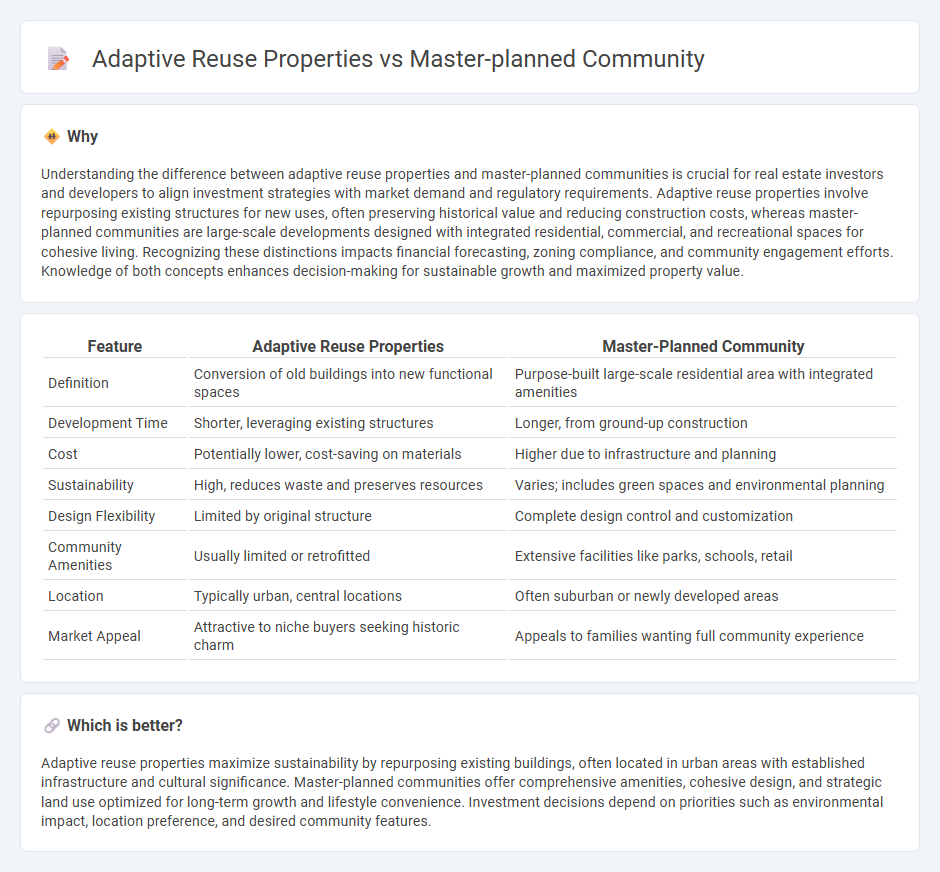
Adaptive reuse properties transform existing buildings into functional real estate spaces, maximizing urban renewal and sustainability by repurposing structures like warehouses or factories. Master-planned communities offer meticulously designed neighborhoods with integrated amenities, infrastructure, and mixed-use zones, fostering cohesive, long-term residential environments. Explore the advantages and unique opportunities of each approach to enhance your real estate investment strategy.
Why it is important
Understanding the difference between adaptive reuse properties and master-planned communities is crucial for real estate investors and developers to align investment strategies with market demand and regulatory requirements. Adaptive reuse properties involve repurposing existing structures for new uses, often preserving historical value and reducing construction costs, whereas master-planned communities are large-scale developments designed with integrated residential, commercial, and recreational spaces for cohesive living. Recognizing these distinctions impacts financial forecasting, zoning compliance, and community engagement efforts. Knowledge of both concepts enhances decision-making for sustainable growth and maximized property value.
Comparison Table
| Feature | Adaptive Reuse Properties | Master-Planned Community |
|---|---|---|
| Definition | Conversion of old buildings into new functional spaces | Purpose-built large-scale residential area with integrated amenities |
| Development Time | Shorter, leveraging existing structures | Longer, from ground-up construction |
| Cost | Potentially lower, cost-saving on materials | Higher due to infrastructure and planning |
| Sustainability | High, reduces waste and preserves resources | Varies; includes green spaces and environmental planning |
| Design Flexibility | Limited by original structure | Complete design control and customization |
| Community Amenities | Usually limited or retrofitted | Extensive facilities like parks, schools, retail |
| Location | Typically urban, central locations | Often suburban or newly developed areas |
| Market Appeal | Attractive to niche buyers seeking historic charm | Appeals to families wanting full community experience |
Which is better?
Adaptive reuse properties maximize sustainability by repurposing existing buildings, often located in urban areas with established infrastructure and cultural significance. Master-planned communities offer comprehensive amenities, cohesive design, and strategic land use optimized for long-term growth and lifestyle convenience. Investment decisions depend on priorities such as environmental impact, location preference, and desired community features.
Connection
Adaptive reuse properties contribute significantly to master-planned communities by repurposing existing structures, enhancing sustainability, and preserving local heritage. These revitalized buildings offer unique spaces for residential, commercial, or mixed-use purposes, aligning with the comprehensive vision of master-planned developments. Integrating adaptive reuse within master-planned communities supports economic viability, environmental stewardship, and diverse architectural character.
Key Terms
**Master-planned community:**
Master-planned communities are large-scale residential developments meticulously designed with integrated amenities such as parks, schools, shopping centers, and recreational facilities to create a cohesive living environment. These communities emphasize long-term sustainability, comprehensive infrastructure, and a balanced mix of residential, commercial, and green spaces, often boosting property values and resident satisfaction. Discover more about the benefits and features of master-planned communities to understand their growing appeal in urban development.
Zoning
Master-planned communities benefit from comprehensive zoning approvals that allow for cohesive development of residential, commercial, and recreational spaces under a unified plan, ensuring consistent land use and infrastructure alignment. Adaptive reuse properties often face complex zoning challenges, requiring variances or special permits to convert existing structures to new uses, reflecting the intricacies of retrofitting buildings within established zoning regulations. Explore deeper insights on zoning strategies to optimize development potential for both master-planned communities and adaptive reuse projects.
Amenities
Master-planned communities offer a wide range of amenities such as recreational facilities, parks, schools, and shopping centers designed to provide a cohesive lifestyle experience. Adaptive reuse properties, often urban and historic, focus on incorporating unique architectural features and localized amenities like boutique shops, art spaces, and trendy eateries. Explore the benefits of each to find the ideal living environment tailored to your lifestyle preferences.
Source and External Links
Planned community - A master-planned community is a carefully designed and constructed residential area developed from its inception on previously undeveloped land, often including a mix of land uses and amenities to create a cohesive, well-organized environment.
Top Up-and-Coming Master Plan Communities in Metro Denver - These communities focus on safe, friendly living with amenities such as parks, trails, schools, and programs designed to build a strong sense of neighborhood and lifestyle security for families.
Master Planned Community Development - Developers like McWhinney build master-planned communities that integrate diverse land uses, inspiring design, and placemaking to foster vibrant, sustainable, and multi-use environments suited for a range of residents and businesses.
 dowidth.com
dowidth.com